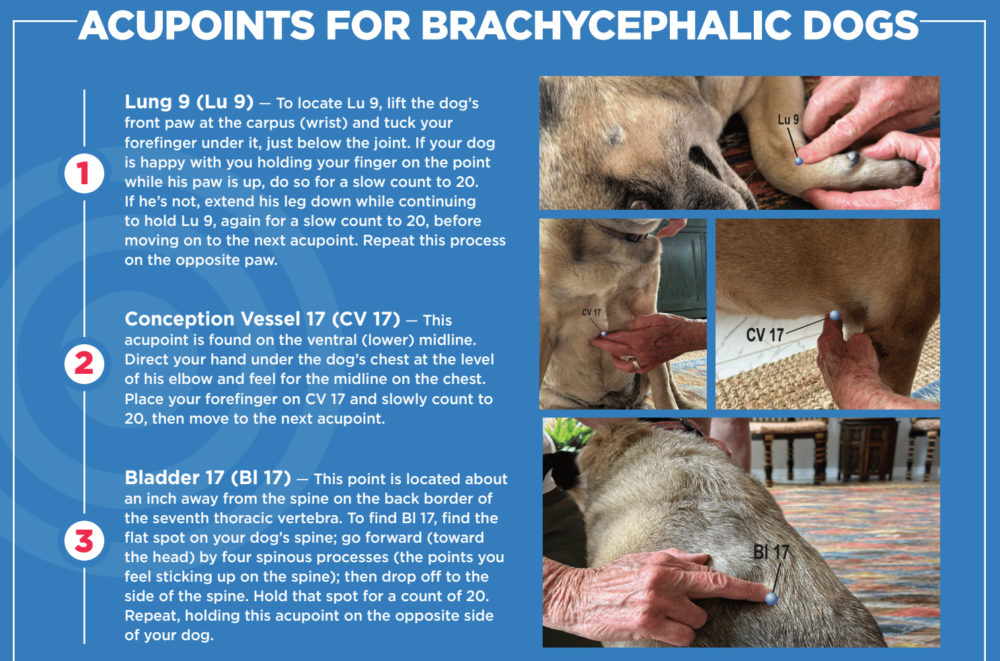
Flat-faced dogs like pugs and Boston terriers are undeniably cute — but their short noses mean they’re prone to respiratory problems. This acupressure session can help your brachycephalic companion breathe better.
If you share your life with a brachycephalic dog, then you’re well aware that these flat-faced, short-nosed breeds are susceptible to breathing issues that can be uncomfortable at best, and life-threatening at worst. Besides avoiding strenuous exercise, managing stress, and keeping your brachycephalic dog indoors during hot, humid weather, you can also use a simple at-home acupressure session to help improve their breathing.
Understanding Brachycephaly
“Brachycephalic” is the technical term for flat-faced dog breeds, of which there are 40. While we often associate it with small breeds like pugs, Boston terriers, Shih tzus, and Pekingese, dogs of all sizes can be affected, including larger breeds like the bull mastiff, bulldog, Cane Corso, and others.
Did you know? “Brachy” means short and “cephalic” means head.
Interestingly, brachycephaly in dogs isn’t a recent issue. Anthropologists have found remnants of brachycephalic canine skulls in the graves of royalty dating back to ancient Roman times. Pugs, for instance, are among the ancient flat-faced breeds originating in China around 400 BC.
During the Victorian era, it became fashionable to selectively breed dogs for aesthetics and novelty. As a result, certain breeds’ faces became flatter and their eyes more prominent. The heads of small brachycephalic breeds became even shorter and more domed to enhance the wrinkles on their brow.
Did you know? Larger canines, such as English bulldogs, were bred for shorter snouts, creating a stronger jaw for fighting and hunting.
Selective breeding of canines has been happening for centuries. However, when dogs are bred for a specific trait, healthy attributes may be lost. This is what has happened to brachycephalic breeds. When the anatomy of any animal is purposefully manipulated for looks, it often compromises their anatomical and functional health and well-being.
What Causes Breathing Problems?
On average, brachycephalic dogs live 8.6 years, while their long-nosed counterparts live around 12.7 years. Shortening the snout and head means these dogs experience significant airway constriction, among other health issues, due to the anatomical malformation of their faces and heads. If the sinuses and jaws are crammed into a tight space, breathing becomes more difficult, and heat builds up in the dog’s body.
Did you know? Flat-faced dogs tend to be exercise- and heat-intolerant.
Labored breathing can tax the animal’s heart. Often, these dogs are born with anatomical abnormalities such as an elongated soft palate that blocks air passing into the trachea (windpipe). The trachea often has a smaller diameter, decreasing the air passages. Additionally, the small, narrow nostrils in these dogs further restrict air flow.
Brachycephalic dogs require more health support than long-nosed breeds, so it’s crucial to work with a holistic or integrative veterinarian throughout their lives. While surgical remedies exist for some breathing impediments, one way you can help your dog breathe easier is through acupressure.
Acupressure Improves Oxygenated Blood Flow
Caring for a brachycephalic dog means providing ongoing breathing support. Acupressure can’t change the animal’s anatomy, but along with proper veterinary care, it can enhance the quality of their breathing. Acupressure supports the function of breathing and the assimilation of oxygen into the dog’s blood.
The acupressure points (acupoints) shown below are intended to help oxygenated blood circulate through the dog’s body, nourishing all internal organs and tissues.
Did you know? Even with their health issues, brachycephalic dogs make loving, devoted companions.

About the Authors:
Amy Snow is one of the authors of ACU-DOG: A Guide to Canine Acupressure, ACU-CAT: A Guide to Feline Acupressure, and ACU-HORSE: A Guide to Equine Acupressure. They founded Tallgrass Animal Acupressure Resources, which offers books, manuals, online training courses, DVDs, apps, meridian charts, consulting, and many more acupressure learning tools and opportunities. Email: tallgrass@animalacupressure.
Nancy Zidonis is one of the authors of ACU-DOG: A Guide to Canine Acupressure, ACU-CAT: A Guide to Feline Acupressure, and ACU-HORSE: A Guide to Equine Acupressure. They founded Tallgrass Animal Acupressure Resources, which offers books, manuals, online training courses, DVDs, apps, meridian charts, consulting, and many more acupressure learning tools and opportunities. Email: tallgrass@animalacupressure.
This article was originally published on Pet Lovers Diary.
